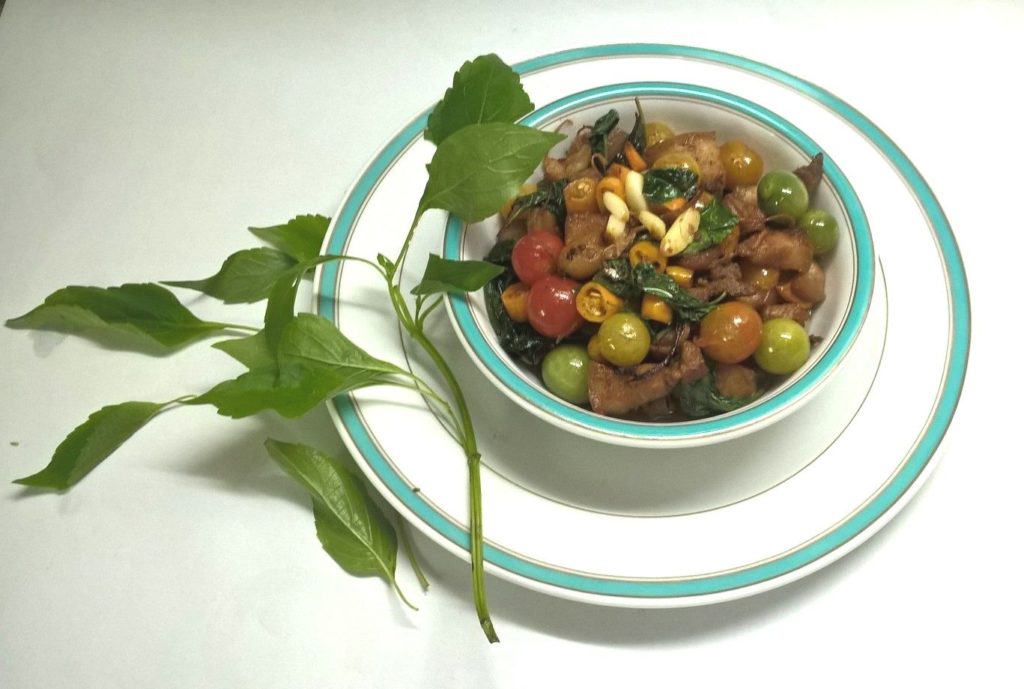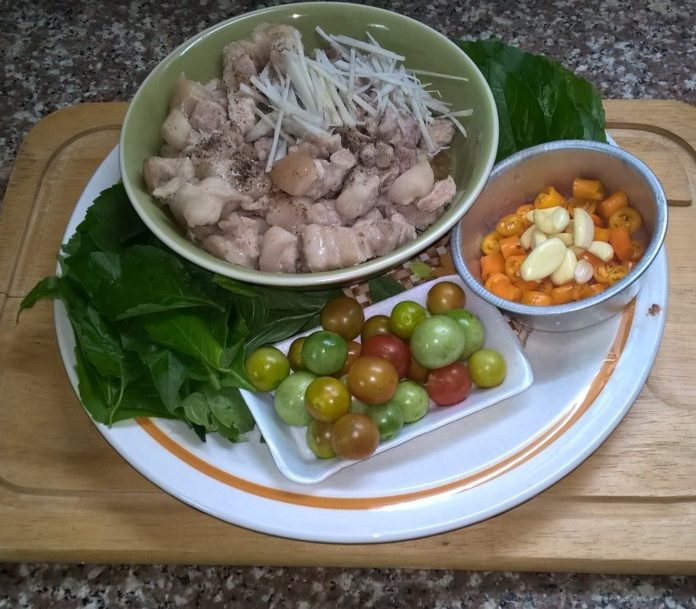| ผู้เขียน | Danai Huntrakul |
|---|---|
| เผยแพร่ |
จู่ๆ อยู่มาวันหนึ่ง น้องชายบอกว่าหลังบ้านปลูกยี่หร่า ใช้ใบสดผัดกับเนื้อ ทำให้รอดจากเนื้อผัดกะเพราที่จำเจไปได้อีกหลายมื้อในชีวิตนี้
ผมเริ่มได้ยินเรื่องยี่หร่าเมื่ออยู่ชั้นมัธยมศึกษาตอนปลาย จาก กาพย์เห่เรือชมเครื่องคาวหวาน พระราชนิพนธ์ในพระบาทสมเด็จพระพุทธเลิศหล้านภาลัย รัชกาลที่ 2 ว่าใช้ในแกงมัสมั่น
หลังจากนั้น เมื่อหัดทำแกงเผ็ด ก็ได้ความรู้จากแม่ว่า ถ้าแกงเนื้อวัว ให้เติมเม็ดยี่หร่าคั่วแล้วตำแหลก ใส่เข้าไปด้วย จะช่วยดับคาว ซึ่งผมก็ไม่ถือเคร่งครัด ด้วยไม่เคยตำเครื่องแกงเองมาก่อน เวลาเข้าตลาดสดบอกแม่ค้าว่าจะแกงเนื้อนั่นเนื้อนี่ แม่ค้าก็จัดเครื่องแกงสำเร็จให้ แต่ก่อนนี้ ยังเห็นที่เวลาตักเครื่องแกง แม่ค้าเขาใช้ไม้พายเล็กๆ ป้ายที่ตำสีต่างๆ จากชามนั้นชามนี้ นัยว่าเพื่อเพิ่มกลิ่นรสจำเพาะให้แกงแต่ละชนิด ซึ่งเดี๋ยวนี้ไม่เห็นแม่ค้าเจ้าไหนทำกันอีกเลย เครื่องแกงแต่ละกะละมังสูตรสำเร็จ มี แกงเขียวหวาน แกงเผ็ด อย่างหยาบหรือละเอียด แกงคั่ว แกงส้ม เป็นมาตรฐาน ถ้าจะทำแกงมัสมั่นต้องไปหาซื้อตามเจ้าพิเศษ ซึ่งหาไม่ค่อยง่ายนัก
เครื่องแกงสำเร็จกะละมังเหล่านี้ ห้ามเติมนั่นเติมนี้อีก คนซื้อไม่ต้องยืนรอ แม่ค้าก็ไม่ต้องคิดประดิดประดอยปรุงอะไรอีก แค่ตักใส่ถุงพลาสติกชั่งแล้วคิดเงิน เท่านั้น แต่สำหรับผม มันรู้สึกขาดฉากสำคัญที่เราคุ้นตอนเข้าตลาดจ่ายกับข้าวตั้งแต่เด็ก กลายเป็นว่า วันเวลาที่ผ่านไปเดี๋ยวนี้ ค่อยๆ กลืนรสสัมผัสบุคคล (Human touch) จนแทบจะไม่เหลือในเรื่องกินอยู่ไปทุกที ตั้งแต่ที่ตลาดสด มาถึงหน้าเตาร้านขายอาหารตามสั่ง คนทำส่วนใหญ่จะทำๆ ไป เหมือนเสียไม่ได้ หรือไม่ก็อ้างว่าต้องรีบ อาหารแต่ละจานก็เลยมีรสชาติดาดๆ กินแล้วไม่อร่อย ทั้งๆ ที่เป็นจานง่ายๆ ธรรมดา ซึ่งถ้าครัวบ้านไหนขาดรสสัมผัสนี้ไปอีกละก็ บ้านก็จะไม่เป็นบ้านอีกต่อไป

แปลกที่ว่า ผมไปเริ่มสนใจกับเครื่องเทศไทยเอาตอนทำกับข้าวฝรั่ง ซึ่งแตกต่างกันทั้งกลิ่นรส มีบุคลิกเด่นแยกกันชัดมาก แล้วให้ทึ่งกับการที่กับข้าวบางอย่าง เข้ายี่หร่า เทียนข้าวเปลือก ใบเปราะหอม ฯลฯ จึงได้หันมาสนใจเสาะหาเครื่องเทศพื้นบ้านเรามาใช้ทำกับข้าวเองบ้าง
เม็ดยี่หร่าหาซื้อไม่ยาก แต่ใบยี่หร่าสดนี่ ไม่เคยเห็น หรือไม่รู้จักมาก่อน จนไปติดใจกินแกงปลาดุกใบยี่หร่าร้านคนปักษ์ใต้ที่ตลาดบางจาก กินมาเป็นเดือน จนวันก่อน อดใจเก็บความสงสัยไม่ไหว ถามเจ้าของหรือพ่อครัวหนุ่มไว้หนวด ว่าไปหาซื้อใบยี่หร่าจากที่ไหน เขาบอก เจ้าผักในซอยนี่ไง เวลาใช้ใบยี่หร่า ให้หาข่าอ่อนมาใส่ด้วย เพราะเข้ากันดีนัก ผมเดินไปซอยนั้น เจอแผงผัก ถามหาใบยี่หร่า กำละ 5 บาทเท่านั้น แต่ข่าอ่อน แม่ค้าบอกว่า หมดวัยแล้วค่า ทั้งแม่ค้าและลูกค้า เหลือบไปเห็นมะเขือเทศสีดาลูกสีแดง ส้ม เหลือง เขียว กระทงเล็ก 15 บาท หวนกลับไปเขียงหมู ซื้อสามชั้น 2 เส้น ประมาณ 4 ขีด 55 บาท
กลับเข้าบ้าน ล้างหมู หั่นชิ้นเผื่อหด กะปิ 1 ช้อนโต๊ะ กับข่าซอย คลุกหมู นึ่งจนเนื้อสุกนุ่ม ขณะรอก็หั่นพริกเหลืองข้อเขื่อง แช่น้ำชะเม็ด เด็ดใบยี่หร่า เด็ดขั้วมะเขือเทศ ล้างน้ำ ปอกกระเทียม ไม่ต้องสับ เอาลงเจียวน้ำมัน ใส่เนื้อหมูลงผัดพอได้สี ตามด้วยพริกเหลือง มะเขือเทศ และใบยี่หร่า ลงแค่ใบยี่หร่าสลด เติมน้ำนึ่งหมู ชิมรส ได้เค็มจากกะปิ เปรี้ยวในมะเขือเทศ หวานเนื้อหมูสด ตักใส่ชาม รอหวานใจกลับมากินข้าวด้วยกันค่ำคืนนี้

Stir Fried Pork with Tree Basil Leaf
Unsuspected, one day my younger brother said he planted tree basil in his backyard, so he had it fried with beef, saved from the too-often hot basil for many meals in this life.
I first heard of Cumin in senior high school from “Food and Dessert” barge poem penned by King Rama II; that it is used in Massaman curry.
Later, when I took on curry, I learned from mom that, with beef, adding cumin roasted and pounded will override beef offensive smell. I was not serious then for I never made curry paste; just went to shop and told the vendor what meat for the curry, and the vendor got me the readymade paste. Back then, I saw the vendor used small wood paddle to dip pastes in various colour, to add certain spices called for by each type of curry. Now you don’t see this anymore. Curry paste comes readymade in basin: green, red, Khua and tamarind curry are basic. For massaman curry you have to get it at specialty shop which is not everywhere.
These basins of curry paste need no further dressing. Customer doesn’t have to wait, neither vendor to elaborate; just scoop the paste into plastic bag, scale and charge. But, to me, I felt something missing from when I shopped as a boy. It seems that, as time goes on, along with it goes the human touch, leaving almost nothing in our lifestyle; from the fresh market to the stove of short order food stall; where most cooks would prepare food mindlessly, or with excuse to make haste. So, dishes come out with no character, not savoury even for simple recipe. If any home kitchen lacks such human touch, the house would hardly be home anymore.
Oddly I took interest in Thai spices when cooking western dishes which differ in aroma and flavour, each with distinct characteristic. I was especially awed when some called for cumin, fennel seed, sage, etc. So I turned to our local spices to make some dishes.
Cumin is easy to get; but not the tree basil leaf neither seen nor known by me before; until I got addicted to curry with catfish and tree basil leaf in a Southern food shop at Bang Jaak. After a month, I could not hold my curiosity and asked the bearded owner/cook where he got the leaf. He said at a vegetable stall in this alley; and I should also buy young galangal – they go well together. So I went, found the stall and asked for the leaf – only 5 Baht a bunch; but not so young galangal. I spotted cherry tomatoes in red, orange, yellow and green at ฿15 a small packet; and bought 2 slices of pork belly, about 400 g at ฿55.
Back home, I rinsed pork, cut in size allowing shrinkage, marinated in 1 tbs shrimp paste and shredded galangal; and steamed until soft. Meanwhile, I cut yellow cayenne pepper not so thin, submerged in water to deseed, de-stemmed tree basil leaf and tomato to rinse. Peeled garlic and stir fried in oil; added pork until a bit brown; and broth from steaming, chili, tomato and abruptly the tree basil leaf. Taste for: salty from shrimp paste, sour from tomato and sweet from meat. Transferred to a plate and waited for my sweetheart for dinner.






